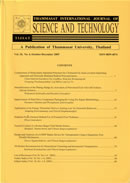ThaiScience
ThaiScience
THAMMASAT INTERNATIONAL JOURNAL OF SCIENCE & TECHNOLOGY
Volume 24, No. 04, Month OCTOBER, Year 2019, Pages 42 - 57
Heat transfer of hydromagnetic convective flow along a semi-circular enclosure filled with nanofluids using a two-dimensional non-homogeneous model
Sharmin Akter
Abstract Download PDF
In this paper, the problem of hydromagnetic convective flow along a semi-circular enclosure filled with nanofluids using a two-dimensional non-homogeneous model have been studied numerically. The circular wall of the enclosure is maintained at constant cold temperature whereas various combinations of the thermal boundary conditions at the bottom heated wall are considered. The enclosure is permeated by an inclined uniform magnetic field and the effects of gravity, Brownian motion and thermophoresis are incorporated into the nanofluid model. In the numerical simulation, here is considered water, kerosene as base fluids and Cobalt as nanoparticles. The Galerkin weighted residual finite element method has been employed to solve the governing partial differential equations after converting them into a non-dimensional form using a suitable transformation of variables. The effects of various parameters such as Hartmann number and Rayleigh number on isotherms have been displayed graphically for nanofluid. The heat transfer augmentation for various thermal boundary conditions has been done from the bottom heated wall for and nanofluid. The results show that the heat transfer rate can be decreased with the increasing values of the Hartmann number but it can be increased by increasing the Rayleigh number. The obtained numerical results also indicate that the variable thermal boundary conditions have significant effects on the flow and thermal fields. Finally, it is observed that the heat transfer rate is higher for nanofluid than for nanofluid.
Keywords
Heat transfer, Nanofluid, Finite element method, Thermophoresis, Brownian motionTHAMMASAT INTERNATIONAL JOURNAL OF SCIENCE & TECHNOLOGY
Published by : Thammasat University
Contributions welcome at : http://www.tijsat.tu.ac.th
